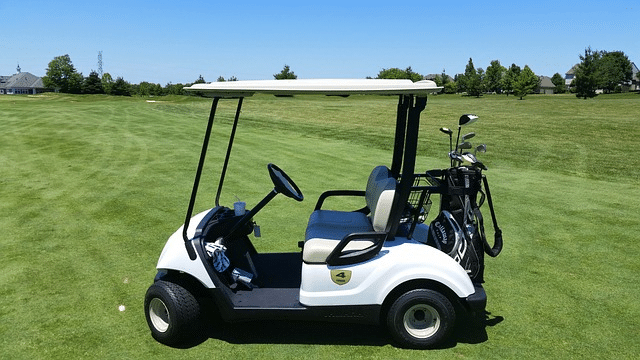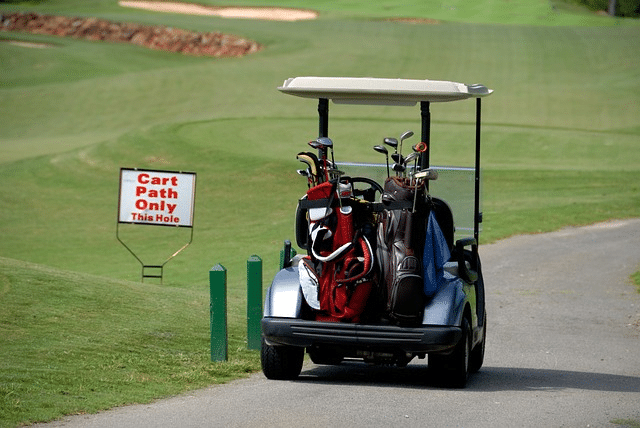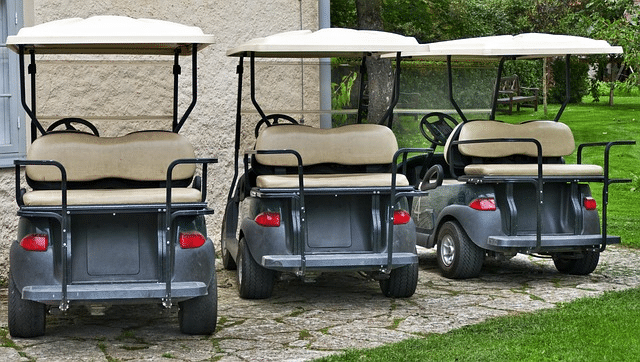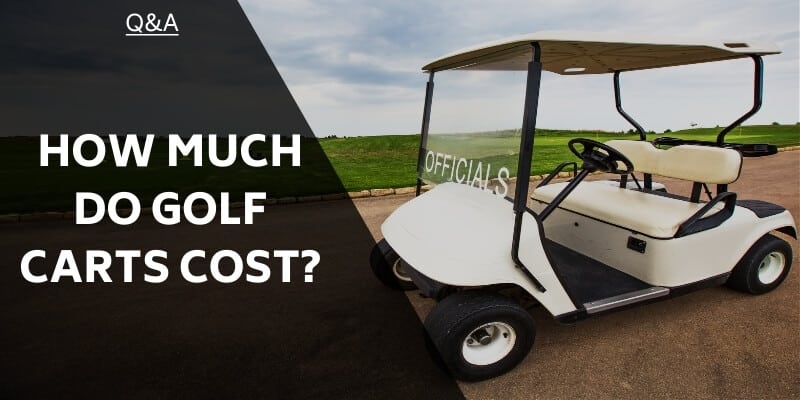A golf cart controller is a device that controls the speed and direction of an electric golf cart. It is located under the cart dashboard and is connected to the battery, motor, and accelerator pedal.
But it is on the list of the top 5 golf cart parts that break the most often.
A golf cart controller usually costs $300 to $800 to fix. How can you tell when your golf cart will break down because of a bad controller?
Here are the 7 biggest symptoms of a bad controller on a golf cart:
- Golf cart jerks when you accelerate.
- You turn the key in the ignition, but nothing happens.
- The golf cart speeds up suddenly without warning.
- Golf cart slows down without warning.
- Your golf cart stalls even with your foot on the pedal.
- The golf cart hits a limited speed.
- No volts register on the controller’s volt meter.
If your cart has any of these, you’ll want to understand the details so you can fix the problem without wasting money.
Read on to learn how to diagnose symptoms of a bad controller on your golf cart and, more importantly, how to fix it.
What Is A Golf Cart Controller?
A golf cart controller is the brain of your golf cart. It’s the little box under the dashboard that controls the speed and direction of your cart.
When you press the gas pedal, the controller sends a signal to the motor to make the cart go faster. When you release the gas pedal, the controller sends a signal to the motor to make the cart go slower. The controller also controls the direction of the cart by sending signals to the motor to turn the wheels.
The golf cart controller is an important part of the golf cart’s electrical system. It ensures that the cart is able to operate safely and efficiently. Without a controller, the cart would not be able to move.
Here are some interesting facts about golf cart controllers:
- There are two main types of golf cart controllers: mechanical and electronic. Mechanical controllers are the older type of controller made up of gears and linkages. Electronic controllers are the newer type of controller made up of transistors and other electronic components.
- Electronic controllers are more efficient than mechanical controllers and offer more features like cruise control and reverse.
- The cost of a golf cart controller varies depending on the type of controller, the features it offers, and the manufacturer.
7 Symptoms of Bad Controller on Your Golf Cart & How To Fix It
1. Golf Cart Jerks When You Accelerate
One of the problems is that the golf cart will jerk whenever you accelerate. While this relates more to a dirty clutch or a misaligned inductive throttle sensor, it can indicate the proper voltage didn’t reach your speed controller.
This is one of the golf cart controller symptoms for when it starts to go bad. Loose terminal connections highlight one of the most common reasons for the jerky movements. A poor connection with the terminal will reduce the current flowing through the batteries and to the controller.
In some cases, the battery terminal post corroded to where it won’t connect properly. You must replace the battery altogether in those cases.
Troubleshooting
To begin troubleshooting a golf cart that jerks, first you need to pinpoint the source. For example, in cases where the battery cable corroded off, you would replace the battery cable. In cases where the battery terminal post corroded away, you need to replace the battery altogether.
With a gas golf cart, jerky movements may happen when you accelerate because of damage to the primary clutch weights. Clean your golf cart regularly to keep dust and dirt from interfering with your golf cart’s operation. You can clean away the dust and dirt for better operation, but a damaged clutch requires repairs from a professional.
2. You Turn The Ignition But Nothing Happens

You turn the key, but nothing happens. Usually, this means that you have a burned-out coil, also known as solenoid failure.
Solenoid failure happens when the controller on the golf cart meters out the incorrect voltage level and burns out the coil. Pay close attention to if you hear a clicking sound when you turn the key because no clicking sound means a high likelihood of solenoid failure.
Troubleshooting
This could be the controller for golf cart, but it could also relate to other things. For example, if you turn the key and hear a clicking sound, the issue more than likely relates to the electrical components. Check your wire connections for cleanliness and tightness.
Gas golf carts often struggle with this issue due to battery problems. Check for a full charge on the battery packs for electrical golf carts. Let it sit on the charger if it’s low on battery, but otherwise, check the battery cables and ports for corrosion since this can interfere with a charge.
Related article: How Long Do Golf Carts Last?
3. The Golf Cart Speeds Up Suddenly Without Warning
Your golf cart speeding up suddenly without warning is one of the signs that your controller may be going bad. To understand why this happens, let’s take a look at the simple principle of a golf cart controller. The controller alters the power of your golf cart’s motor, which lets you control the speed and the torque. When the controller starts to go bad, it controls the power of the motor in erratic ways to where it will speed up without warning.
Troubleshooting
As we said in the safety section, put the golf cart into TOW mode before you diagnose it. This safety feature turns off the motor and locks the golf cart into place so it can’t turn. Whenever you perform maintenance, this prevents damage to the controller from electrical surges.
After you’ve put it into TOW mode, check for looseness on the wires and terminals. This issue usually requires you to replace the controller if nothing looks loose.
4. Golf Cart Slows Down Without Warning

Especially if you drove the cart at full speed and it slows down suddenly, the issue likely stems from a bad controller. The sudden slowdown happens because the motor receives too little electricity to maintain its high speed.
In some cases, your golf cart slows down while driving, and it’s a simpler fix like a low charge in the battery or insufficient water levels in the battery.
Finally, golf carts may slow down suddenly when the speed sensor goes bad. You should resolve this one quickly because I’ve seen people fall out of a moving golf cart due to the dramatic speed change. A golf cart behind you also may not stop in time either and cause a collision.
While that may seem innocuous due to low speeds, over 15,000 people suffer injuries in golf cart accidents each year. Even worse, 48% (7,200 of the 15,000) of those injured will need hospitalization.
Troubleshooting
If the speed sensor has gone bad, replace the magnet as well. You can find the speed sensor on the motor in the area not attached to the transaxle. Look for it right in the middle. You’ll see a black plastic circle with three wires that run to it. The speed sensor can be two types: The first snaps in flush with the motor case. The second type will use a top-hat style screw that will stand up off the top of the motor but screws to the motor. Check underneath the sensor for the magnet, which will often be damaged if the speed sensor isn’t working.
Most often, when the golf cart slows down suddenly, it happens because of a communication problem between your controller and the speed sensor.
Related article: The Best Golf Cart Brands on the Market
5. Your Golf Cart Stalls Even with Your Foot on the Pedal
When your golf cart stalls, you know something went wrong, but you may not know what went wrong. A stalled golf cart especially poses a danger if it suddenly stops in a crowded area or while you cross an intersection. Your golf cart may stall because of the motor controller, which communicates with your golf cart so that it knows how fast or slow to go. Sometimes, you may think the motor controller went bad, but the issue stems more from the solenoid failing.
Golf cart controllers come in two sizes 200-300 amp controllers and 300-600 amp controllers. The 300-600 amp controller can go uphill easier and handle a larger passenger capacity. Generally, 200-300 amp controllers were meant for 2-passenger golf carts, 300-600 amp controllers can handle 4 passengers, and you have more room for golf cart accessories.
Troubleshooting
Check the controller and its wiring for signs of damage. Most controllers include a built-in language that will flash Morse code from the operation light to tell you what happened. Wire damage around the ignition coil can make your golf cart stall. You may need to replace the wiring in this area of the cart.
Don’t ignore a stalling issue. Especially if your golf cart goes back to normal, you may feel tempted to ignore the problem, but a golf cart stalling never improves with time. Something internally was damaged, and you will need to make repairs on it.
6. Golf Cart Has Limited Speed
Most golf carts will only reach a top speed of 15 mph, but you may find yourself pushing it hard without it even coming close to the top speed. Most commonly, the golf cart hits a limited speed because of insufficient power from the battery or your speed sensor malfunctioning.
In particular, when the speed controller is at fault, the golf cart moves, but you will feel several breaks in between. You may struggle to get the golf cart to move at a steady speed because the voltage being given to the motor is out of whack.
Troubleshooting
As a side note, troubleshooting EZ Go golf cart controller will normally be done with a maintenance switch called the TOW switch. You need to flip that switch whenever you work on your speed
controller. This kills the power and keeps from damaging your controller.
Most of the time, this switch sits under your golf cart’s seat. Check your owner’s manual and do it according to the manual.
Once you flip the switch, check all the wires for loose connections. If that doesn’t fix the problem, you may want to reset your golf cart. Hit the reset button located next to the main battery supply. Resetting it will correct minor issues.
Related article: Gas vs Electric Golf Cart
7. No Volts Register on the Controller’s Volt Meter

If you want to know how to test a golf cart motor controller when no volts register on the controller’s volt meter, it gives you one of the surest signs that your controller is in the process of failing. Test the power that goes to your motor controller. If no volts show, you may need to replace the controller before it starts to give you problems.
However, this issue isn’t as problematic as the others mentioned, but you want to replace it.
Troubleshooting
Every golf cart controller will have two pins on it, which control your speed through the voltage applied. A higher voltage will increase the speed of your golf cart through the pin, and a lower voltage will go through the other pin. When you operate the golf cart, it connects to the potentiometer that the pedal controls. When you push down on the pedal, this should result in a higher voltage. If the volt meter shows no voltage, this is why the problem is associated with the controller.
Understanding Golf Cart Safety
Before trying to fix a golf cart controller, consult your owner’s manual and follow all the safety precautions. For example, look in the Yamaha golf cart controller troubleshooting section of the owner’s manual.
Some common safety measures include wearing the proper safety equipment (safety glasses, gloves, protective clothing, and appropriate footwear).
Turn the cart ignition off whenever you work on it. Whenever you handle batteries, exercise caution since they can spark, arc, or ignite. Finally, switch the RUN/TOW button under your seat into the TOW position.
FAQs
Why Does a Faulty Controller Cause Stalling of the Cart?
A golf cart stalling happens from a faulty controller because this component controls the motor's voltage. When it malfunctions, it doesn’t receive the correct voltage.
What Are Some of the Preventative Measures That You Can Take for Your Golf Cart?
First, never fool around in a golf cart because it can lead to severe injuries. Second, always click your seat belt since this will prevent you from getting thrown in a collision. Finally, avoid driving over wet, steep, or uneven ground since you risk an accident.
How Do You Test a Golf Cart Controller?
Here’s how to test a golf cart controller: Connect your volt meter and push the pedal of the cart until you hear the solenoid click. It should read full battery pack voltage. If you have full battery pack voltage, put your foot on the pedal slowly until you hit the floor, and you should see the voltage decrease.
What Other Parts Can Cause Problems Similar to a Bad Controller?
The solenoid failing can cause a very similar issue to a bad controller. This is because the two are closely related, but when the solenoid fails, it burns out the coil from too much voltage. That usually happens because of a bad controller giving you the incorrect voltage.
Related article: Best Golf Carts on the Market
Final Thoughts
A golf cart controller is a device that in charge of the speed and direction of your electric golf cart. It is located under the cart dashboard and is connected to the battery, motor, and accelerator pedal.
The symptoms of a bad controller on your golf cart are:
- Jerking when you accelerate
- Cart not starting
- Sudden speed changes
- Slowing down without warning
- Stalling
- Limited speed
- No volts on the controller’s volt meter
If you experience any of these problems, having your golf cart inspected by a qualified technician is important. A bad controller can be a safety hazard, so it is important to have it repaired as soon as possible.
Hopefully, in understanding this, you can have a more fun time out on the course.
Matt travels the world as a professional writer and blogger trying out different golf courses in exotic spots like the Philippines. He loves the challenge and tranquility in the sport of golf. Golf, for him, is a way of relaxing and enjoying life. You can connect with him on LinkedIn.







